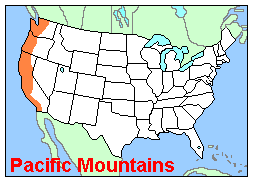America's Volcanic Past -
Cascade Range
| "Though few people in the United States may actually experience an erupting volcano, the evidence for earlier volcanism is preserved in many rocks of North America. Features seen in volcanic rocks only hours old are also present in ancient volcanic rocks, both at the surface and buried beneath younger deposits." -- Excerpt from: Brantley, 1994 |

Location Map - Major Volcanoes of the Cascade Range
[9K,GIF]

MORE America's Volcanic Past -
Washington State

MORE America's Volcanic Past -
Oregon

MORE America's Volcanic Past -
California
[This list is just a sample of various Cascade Range volcanic features or events and is by no means inclusive.]
- Cascade Range
- Pacific Mountain System
- Cascade Range Vulcanism
- Major Cascade Range Volcanoes
- Cascade Range National Parks
The Cascades arose through the plate collisions that have
enlarged the western continent in Tertiary-to-Holocene
time. This mountain range contains such large and
geologically recent active volcanoes as Rainier, Hood,
and Shasta.
Excerpt from: USGS A Tapestry of Time and Terrain Website, 2001 |
||||||

Pacific Mountain System
Pacific Mountain System:3
Cascade Range Region:3
Cascade Range and Plate Tectonics:1 The Cascade Range has been an active arc for about 36 million years as a result of plate convergence. Volcanic rocks between 55 and 42 million years ago occur in the Cascades, but are probably related to a rather diffuse volcanic episode that created the Challis arc extending southeastward from northern to northwest Wyoming. Convergence between the North American and Juan de Fuca plates continues at about 4 centimeters per year in the direction of North-50-degrees-East, a slowing of 2-3 centimeters per year since 7 million years ago. According to most interpretations, volcanism in the Cascades has been discontinuous in time and space, with the most recent episode of activity beginning about 5 million years ago and resulting in more than 3000 vents. Holocene Volcanism and the Cascade Arc:2 Holocene volcanism in the Cascades extends from the Garibaldi Volcanic Belt in southern British Columbia to the Lassen volcanic complex in northern California. Pronounced differences in the nature of volcanism occur along the arc. In Washington there are five, generally large, widely spaced stratovolcanoes, with only one (Mount Adams) having significant nearly basaltic volcanics. In marked contrast, Oregon has six generally smaller stratovolcanoes, but the entire state is traversed by a 40-50-kilometer-wide band of basaltic to andesitic lava shields, cinder cones, and smaller stratovolcanoes that the "Cascade" cones rise above. South of Crater Lake, the Cascade arc bends perceptibly toward the southeast, and continues along this trend to Lassen Peak. Both Lassen and Shasta are associated with eastward halos of mafic shields and lava fields which, near Shasta, culminate in the huge shield volcano of Medicine Lake.
Pacific Northwest "Ring of Fire":3
The Cascades volcanoes define the Pacific Northwest section of the "Ring of Fire", a fiery array of volcanoes that rim the Pacific Ocean. As if volcanic hazards were not enough, the Ring of Fire is also infamous for its frequent earthquakes. In order to understand the origins of this concentrated band of Earth hazards we have to take a peek beneath our feet. Beneath the Cascades, a dense oceanic plate plunges beneath the North American Plate; a process known as subduction. As the oceanic slab sinks deep into the Earth's interior beneath the continental plate, high temperatures and pressures allow water molecules locked in the minerals of solid rock to escape. The water vapor rises into the pliable mantle above the subducting plate, causing some of the mantle to melt. This newly formed magma rises toward the Earth's surface to erupt, forming a chain of volcanoes (the Cascade Range) above the subduction zone.
The Cascade Range made its first appearance 36 million
years ago, but the major peaks that rise up from today's volcanic centers
were born within the last 1.6 million years (Pleistocene). More than
3000 vents erupted during the most recent volcanic episode that began 5 million years
ago. Are there more eruptions in our future? As long as subduction continues, new
Cascade volcanoes will continue to rise.
|
| Major Cascade Range Volcanoes |
| Cascade Range National Parks |
- Crater Lake National Park
- Lassen Volcanic National Park
- Lava Beds National Monument
- Mount Rainier National Park
- Mount St. Helens National Volcanic Monument
- Newberry National Volcanic Monument
Excerpts from:
1) Swanson, et.al., 1989, Cenozoic Volcanism in the Cascade Range and Columbia Plateau, Southern Washington and Northernmost Oregon: AGU Field Trip Guidebook T106
2) Wood and Kienle, 1990, Volcanoes of North America: United States and Canada: Cambridge University Press, contribution by Charles A. Wood
3) USGS/NPS Geology in the Parks Website, 2001
4) USGS A Tapestry of Time and Terrain Website, 2001
[Return to
America's Volcanic Past - States and Regions]
[Return to
America's Volcanic Past - National Parks and Monuments]
[Return to
Visit A Volcano Menu]



